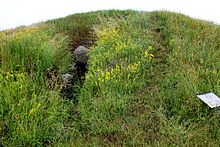Rævehøj from Dalby
The Rævehøj Dalby (also called Rævehøj of Gørlev; German Fuchs hill ) is a megalithic type passage grave the Beaker culture (TBK), the v 3500-2800. BC originated. The passage grave is a form of Neolithic megalithic systems, which consists of a chamber and a structurally separated, lateral passage. This form is primarily found in Denmark, Germany and Scandinavia , as well as occasionally in France and the Netherlands.
Rævehøj is not far from Regnershøj , south of Kalundborg near the coast of the Great Belt , on the Danish island of Zealand . Neolithic monuments are an expression of the culture and ideology of Neolithic societies. Their origin and function are considered to be the hallmarks of social development.
description
The chamber, which is approximately 7.0 m long and 2.2 m wide in the middle, consists of 19 supporting stones that support the five capstones of the chamber via three intermediate layers. With an inner ceiling height of 2.5 m, the system is the highest chamber in Denmark. The round hill is 4.5 m high. The corridor consists of 17 bearing stones and has three preserved cap stones.
During the Bronze Age , the chamber was reused and wheel crosses were carved into one of the bearing stones , which Therkel Mathiassen (1892–1967) discovered in the 1940s. It is quite common for Stone Age large stone tombs to be used for subsequent burials , but carvings inside the facilities are rare.
Rævehøj was examined for the first time in 1852 by fox hunters who got inside through a hole in the ceiling of the passage grave. In the 1930s, it was examined by Gustav Rosenberg, an expert in restoring large stone graves. In the corridor, which is relatively rare, the locking plate was found that blocked access to the chamber.
In the chamber, he found small clay pots, an undecorated bowl with a flat bottom, a dagger and a discount from flint . Human bones were in different places. Fireplaces, urn burials and stone setting from the Bronze Age were found in the burial mound .
See also
literature
- Peter V. Glob : prehistoric monuments of Denmark. Wachholtz, Neumünster 1968.
Individual evidence
- ^ Johannes Müller : Neolithic Monuments and Neolithic Societies. In: Hans-Jürgen Beier , Erich Claßen, Thomas Doppler, Britta Ramminger (eds.): Varia neolithica VI. Neolithic Monuments and Neolithic Societies. Contributions from the meeting of the Neolithic Working Group during the annual meeting of the North-West German Association for Ancient Research in Schleswig, 9. – 10. October 2007 (= contributions to the prehistory and early history of Central Europe. Vol. 56). Beier & Beran, Langenweißbach 2009, ISBN 978-3-941171-28-2 , pp. 7-16, here p. 15.
Web links
Coordinates: 55 ° 30 '48 " N , 11 ° 10' 9.4" E


